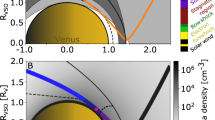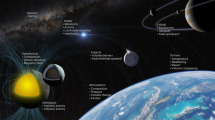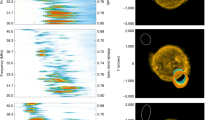Abstract
THREE of the most important solar disturbances observed during 1956 were the great eruptive prominence of February 10 and the large flares of May 17 and August 31. For a week or two after each of these events, a sequence of phenomena involving Venus, the Earth and the Moon were observed with a radio telescope operating on a wave-length of 11 m.1, these events appearing to be related to the preceding solar disturbance. In one case strong signals of apparent Venusian origin were observed a number of days after the solar disturbance, and a few days later a phenomenon was observed which, presumably, was caused by the presence of a large ion cloud near the Moon. Such a sequence of events suggests that a stream of particles ejected by the Sun and travelling earthward first encountered the planet Venus, resulting directly or indirectly in the production of strong 11-m. radio signals from Venus. Drifting farther out, the particles reached the vicinity of the Earth, with some of the particles forming a cloud near the Moon.
This is a preview of subscription content, access via your institution
Access options
Subscribe to this journal
Receive 51 print issues and online access
$199.00 per year
only $3.90 per issue
Buy this article
- Purchase on SpringerLink
- Instant access to full article PDF
Prices may be subject to local taxes which are calculated during checkout
Similar content being viewed by others
References
Kraus, J. D., Nature, 178, 33 and 103 (1956).
Menzel, D. H., et al., Astron. J., 61, 186 (1956).
High Altitude Observatory and National Bureau of Standards, Boulder, Colorado, Preliminary Reports of Solar Activity.
Kraus, J. D., Nature, 178, 159 (1956).
Author information
Authors and Affiliations
Rights and permissions
About this article
Cite this article
KRAUS, J. Relation of 11-Metre Solar System Phenomena to Solar Disturbances. Nature 179, 371 (1957). https://doi.org/10.1038/179371a0
Issue date:
DOI: https://doi.org/10.1038/179371a0



